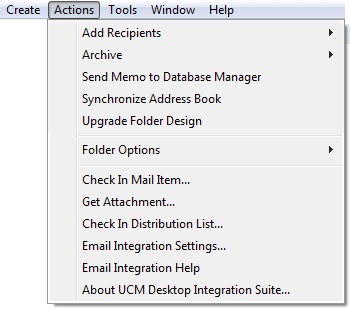5 Integration Into E-mail Clients
This section covers these topics:
5.1 About E-mail Client Integration
After installing the Desktop Integration Suite software on your computer, you can check in e-mail messages and their attachments to a content server directly from Microsoft Outlook or Lotus Notes and share them with others in your organization. You can drag and drop e-mails directly into content folders on a server, or you can use a special content check-in form (Oracle Content Server only).
Checked-in e-mail messages are not intended to be checked out, modified, and checked back in. E-mail messages are checked in to a content server for the express purpose of preserving them exactly as they were received. You can open a checked-in e-mail message from a server to view it in your default e-mail application. You can even make changes if you want, but you cannot check it back in to the server. You can, however, send the message to other people or save a copy on your local computer.
For more information on managing e-mail with content server, see Chapter 9, "Working With E-mail."
5.2 Integration Into Microsoft Outlook
Desktop Integration Suite can work with Microsoft Outlook 2002 (XP) through 2010. After installing the integration software, you can interact with content servers and the files on them directly from Microsoft Outlook.
Desktop Integration Suite adds various integration features to Microsoft Outlook:
5.2.1 Oracle Content Servers Hierarchy in Mail Folders
The Desktop Integration Suite client software adds a hierarchical folder structure called Oracle Content Servers to the mail folders list in Microsoft Outlook (Figure 5-1). For more information on the integration hierarchy in your e-mail application, see Chapter 6, "Understanding the Integration Hierarchy."
Note:
The Oracle Content Servers hierarchy is not displayed in the mail folders list by default. You must specifically enable it. For more information, see Section 5.6, "Showing or Hiding the Oracle Content Servers Hierarchy."Figure 5-1 Integration Hierarchy in Microsoft Outlook 2007
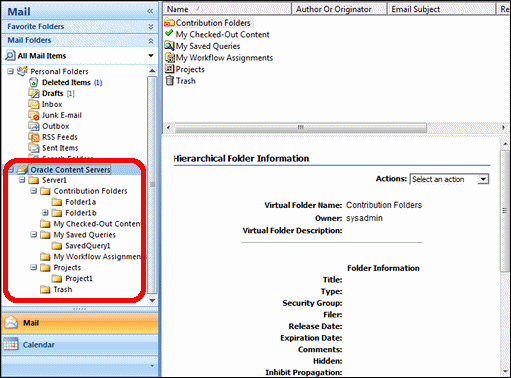
Description of "Figure 5-1 Integration Hierarchy in Microsoft Outlook 2007"
5.2.2 Integration Items in Outlook 2002, 2003, and 2007
The Desktop Integration Suite client software adds two integration items to the Microsoft Outlook 2002, 2003, and 2007 interfaces:
The Desktop Integration Suite client software adds a menu called Oracle UCM (Oracle Universal Content Management) to the menu bar in Microsoft Outlook 2002, 2003, and 2007 (Figure 5-2).
Figure 5-2 Oracle UCM Menu in Microsoft Outlook 2007
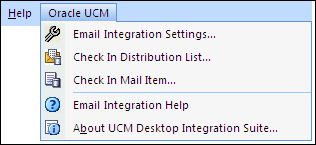
Description of "Figure 5-2 Oracle UCM Menu in Microsoft Outlook 2007"
The Oracle UCM menu contains the following menu items:
-
Email Integration Settings...: This option opens a dialog where you can set a number of configuration options for the e-mail client integration. For more information, see Section A.20, "Email Checkin Settings Dialog."
-
Check In Distribution List...: This option opens a dialog where you can check an e-mail distribution list in to a content server. For more information, see Section A.21, "Distribution List Checkin Dialog."
-
Check In Mail Item...: This option opens a dialog where you can check the currently selected e-mail message in to a content server. For more information, see Section A.12, "Check In Content Dialog (E-mail)."
See also Section 9.5, "Checking In E-mail."
-
Email Integration Help: This option launches the online help for Desktop Integration Suite in your standard web browser.
-
About UCM Desktop Integration Suite...: This option opens a dialog that provides version information about the Desktop Integration Suite client software.
The Desktop Integration Suite client software adds a toolbar called Oracle UCM to Microsoft Outlook 2002, 2003, and 2007 (Figure 5-3). If you do not see the toolbar, you can display it by selecting View, then Toolbars, and then Oracle UCM.
Figure 5-3 Oracle UCM Toolbar in Microsoft Outlook 2007
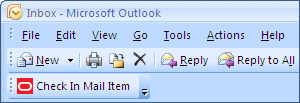
Description of "Figure 5-3 Oracle UCM Toolbar in Microsoft Outlook 2007"
The toolbar items depend on the application context. In the main Outlook window, the Oracle UCM toolbar contains the following option:
-
Check In Mail Item: This option opens a dialog where you can check the currently selected e-mail message in to a content server. (You can also use the Oracle UCM menu to do this.) For more information, see Section A.12, "Check In Content Dialog (E-mail)."
In an e-mail editing window (new message or forward message), the Oracle UCM toolbar contains the following option:
-
Get Attachment: This option opens a dialog where you can select a file on a content server to be attached to the current e-mail message or hyperlinked in the message. For more information, see Section A.25, "Get Attachment Dialog."
5.2.3 Integration Items in Outlook 2010
The Desktop Integration Suite client software adds integration items to three ribbons in the Microsoft Outlook 2010 interface:
The Desktop Integration Suite client software adds a ribbon called Oracle UCM (Oracle Universal Content Management) to the Microsoft Outlook 2010 interface (Figure 5-4).
Figure 5-4 Oracle UCM Ribbon in Microsoft Outlook 2010

Description of "Figure 5-4 Oracle UCM Ribbon in Microsoft Outlook 2010"
The Oracle UCM ribbon includes the following panels:
-
Check In: This ribbon panel contains the following option:
-
Check In Mail Item: This option opens a dialog where you can check the currently selected e-mail message in to a content server. For more information, see Section A.12, "Check In Content Dialog (E-mail)."
See also Section 9.5, "Checking In E-mail.".
-
Check In Distribution List: This option opens a dialog where you can check an e-mail distribution list in to a content server. For more information, see Section A.21, "Distribution List Checkin Dialog."
-
-
Misc: This ribbon panel contains the following options:
-
Email Integration Settings: This option opens a dialog where you can set a number of configuration options for the e-mail client integration. For more information, see Section A.20, "Email Checkin Settings Dialog."
-
Help Contents: This option launches the online help for Desktop Integration Suite in your standard web browser.
-
About UCM Desktop Integration Suite: This option opens a dialog that provides version information about the Desktop Integration Suite client software.
-
The Desktop Integration Suite client software adds a Get Attachment item to the Insert ribbon in Microsoft Outlook 2010 (Figure 5-5). This item opens a dialog where you can select a file on a content server to be attached to the current e-mail message or hyperlinked in the message. For more information, see Section A.25, "Get Attachment Dialog."
Figure 5-5 Integration Item in Insert Ribbon in Microsoft Outlook 2010

Description of "Figure 5-5 Integration Item in Insert Ribbon in Microsoft Outlook 2010"
The Desktop Integration Suite client software also adds a Get Attachment item to the Message ribbon in Microsoft Outlook 2010 (Figure 5-6). This item opens a dialog where you can select a file on a content server to be attached to the current e-mail message or hyperlinked in the message. For more information, see Section A.25, "Get Attachment Dialog."
Figure 5-6 Integration Item in Message Ribbon in Microsoft Outlook 2010

Description of "Figure 5-6 Integration Item in Message Ribbon in Microsoft Outlook 2010"
5.3 Integration Into Lotus Notes
Desktop Integration Suite can work with the Lotus Notes e-mail client version 6.5.2 through 8.5 (with Lotus Domino mail databases based on release 6 or 7 mail templates; release 8 mail templates are currently not supported). After installing the integration software, you can interact with content servers and the files on them directly from the Lotus Notes client.
Desktop Integration Suite adds various integration features to Lotus Notes:
5.3.1 Oracle Content Servers Hierarchy in Mail Pane
The Desktop Integration Suite client software adds a hierarchical folder structure called Oracle Content Servers to the mail pane in Lotus Notes (Figure 5-7). For more information on the integration hierarchy in your e-mail application, see Chapter 6, "Understanding the Integration Hierarchy."
Note:
The Oracle Content Servers hierarchy is not displayed in the mail folders list by default. You must specifically enable it. For more information, see Section 5.6, "Showing or Hiding the Oracle Content Servers Hierarchy."Figure 5-7 Integration Hierarchy in Lotus Notes 8
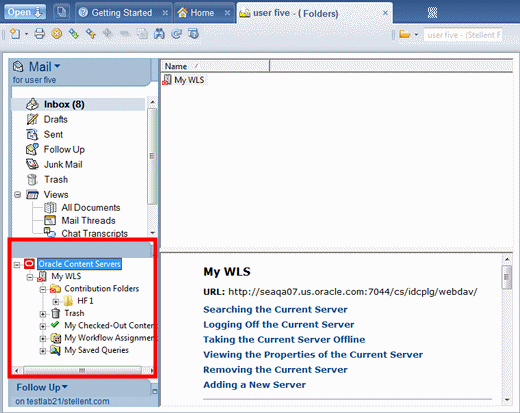
Description of "Figure 5-7 Integration Hierarchy in Lotus Notes 8"
5.3.2 Integration Items in Actions Menu
The Desktop Integration Suite client software adds a number of new items to the Actions menu in Lotus Notes (Figure 5-8).
The standard Actions menu in Lotus Notes includes the following integration items:
-
Check In Mail Item...: This option opens a dialog where you can check the currently selected e-mail message in to a content server. For more information, see Section A.12, "Check In Content Dialog (E-mail)."
See also Section 9.5, "Checking In E-mail."
-
Get Attachment...: This option opens a dialog where you can select a file on a content server to be attached to the current e-mail message. For more information, see Section A.25, "Get Attachment Dialog."
-
Check In Distribution List...: This option opens a dialog where you can check an e-mail distribution list in to a content server. For more information, see Section A.21, "Distribution List Checkin Dialog."
-
Email Integration Settings...: This option opens a dialog where you can set a number of configuration options for the e-mail client integration. For more information, see Section A.20, "Email Checkin Settings Dialog."
-
Email Integration Help: This option launches the online help for Desktop Integration Suite in your standard web browser.
-
About UCM Desktop Integration Suite...: This option opens a dialog that provides version information about the Desktop Integration Suite client software.
5.4 Content Pane and Preview Pane
The integration with your e-mail application (Microsoft Outlook or Lotus Notes) works much as you would expect. You can drag and drop e-mail messages into content server folders, copy and paste e-mail, create shortcuts, and so on.
When you select an object in the Oracle Content Servers hierarchy in the mail pane, the contents of that object are displayed on the right, in the content pane. It may, for example, show a list of all files in the current folder. You may also see a preview pane, which shows additional information about the selected item in the content pane (for example, the content information page for a file on the content server).
If you do not see the preview pane, you may enable it. For more information, see Section 6.8, "Showing or Hiding the Preview Pane."
Figure 5-9 Content pane and preview pane in Microsoft Outlook 2003
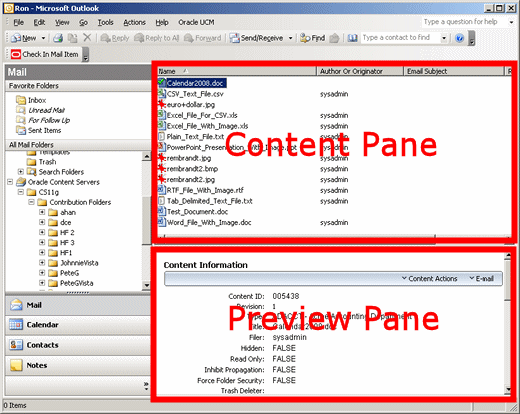
Description of "Figure 5-9 Content pane and preview pane in Microsoft Outlook 2003"
Managed content files listed in the content pane may have a symbol in their file icon to indicate their content management status. For example, if the file is currently checked out by yourself, this is visualized using a green check mark, as shown in Figure 5-10. For a full explanation of all content management status icons, see Section 8.2.5, "Content File Status."
Also, if you hover your mouse cursor over a managed file in the content pane, a screen tip is displayed providing content management information about that file, as shown in Figure 5-11. The following information is provided: the content ID, file size, and, if the file is currently checked out, the user name of the person who checked it out.
5.5 Content Pane View Modes
When you select an object in the integration hierarchy, the content pane shows the contents of that object (for example, a list of files in the current content server folder). How the items are displayed depends on the view mode: icons view, list view, or details view.
Icons view displays your files and folders as large application icons with their names shown below the icons. The files are always sorted by their file name.
List view displays your files and folders as a list of file or folder names preceded by small application icons. The files are always sorted by their file name.
Details view displays your files and folders as in list view, but with additional information such as file type, size, author, security group, timestamp, and the like (if available and relevant). You can sort the files by clicking on any column heading. Click again to reverse the sort order (from ascending to descending, or vice versa). You can define the columns that you want displayed and set their default width (see Section 6.10, "Setting the Column Display").
Note:
In addition to the associated application, the file icons may also show the content management status of the file. For more information, see Section 8.2.5, "Content File Status."To change the view mode in the content pane, move the mouse cursor to any unused area of the content pane, right-click, choose View, and then Icons, List, or Details.
5.6 Showing or Hiding the Oracle Content Servers Hierarchy
You can choose to show or hide the Oracle Content Servers hierarchy in your e-mail application. The Oracle Content Servers hierarchy is not displayed by default.
Note:
In Lotus Notes, you can do this only if you have design rights to the Notes database. If you need any assistance, contact your Lotus Notes administrator.Perform these steps to show or hide the Oracle Content Servers hierarchy in Microsoft Outlook or Lotus Notes:
-
Launch your e-mail application.
-
Microsoft Outlook: Open the Oracle UCM menu or ribbon and then choose Email Integration Settings....
Lotus Notes: Open the Actions menu and then choose Email Integration Settings....
The Email Checkin Settings dialog is displayed (see Section A.20, "Email Checkin Settings Dialog").
-
Select or clear the Show Oracle Content Servers check box to show or hide the integration hierarchy in your e-mail application.
-
Click OK.
-
If you changed the check box status, a reminder is displayed saying that you must restart the e-mail application for the change to take effect. Click OK to continue.
-
Click OK to return to the e-mail application.
Important:
Any changes will not take effect until you restart the e-mail application.